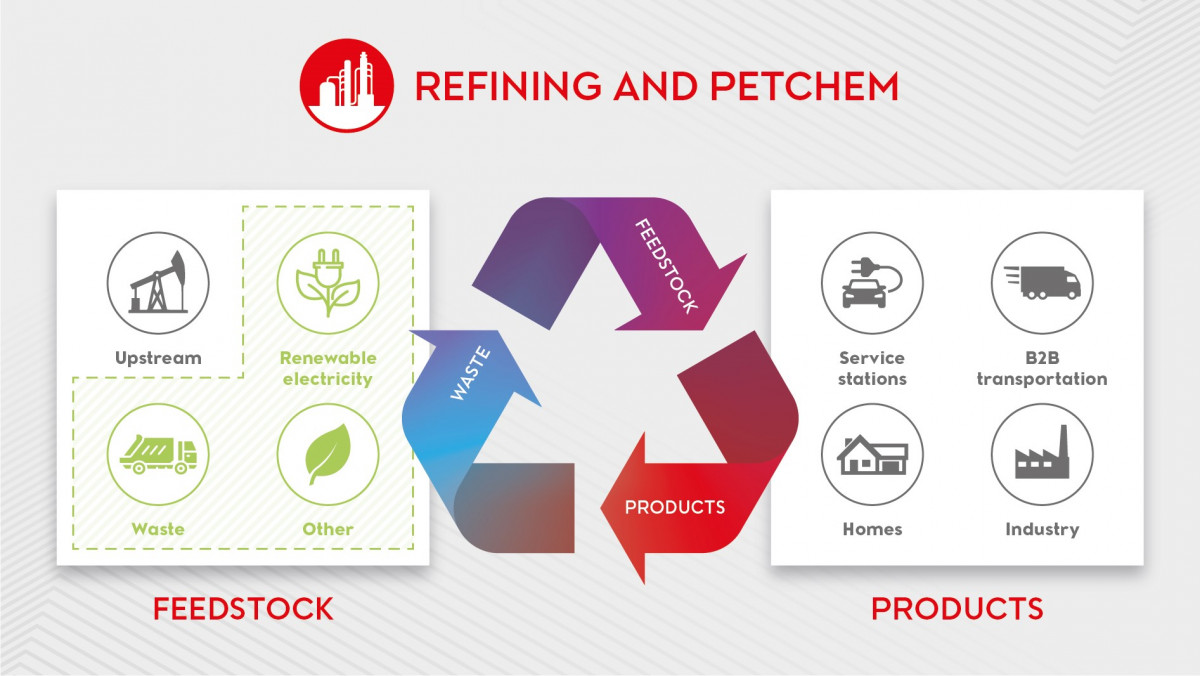Downstream 2030+ vision
The Downstream 2030+ vision reflects on sets a transformational pathway:
‘We are the (Central) European Champion in sustainable chemicals and powering mobility, we are driven by high efficiency and productivity, transforming intelligently, integrating circular business models, being powered by renewable energy and leaving minimal carbon footprint.’

By 2050, MOL Group Downstream is standing on two key business legs: sustainable chemicals and powering mobility, that are integrated into a robust and diversified value chain:
-
Produce and supply ‘European plus’ market with extended sustainable chemical products portfolio (commodities, semi-commodities and specialties),
-
Produce and supply the mobility within the CEE region with conventional and new green fuels alternatives
-
To be fully powered by renewable energy
-
Utilize waste as an important source of green feedstock for sustainable products
-
Operate rationalized portfolio of current and new assets integrated with the cities and industry with a focus on leaving minimal GHG emissions
Key enablers
Within the 2050 horizon we have identified the following 4 main enablers to play a significant role in deciding on the final success of the transformational journey towards the vision.
|
|
Increased efficiency and productivity
|
|---|
Drive the increase of the asset and process efficiency as well as people productivity, which is the basis of success today and it will be in 2030, 2050 and beyond as well. It supports the ability to quickly adapt to changing demand and circumstances and creates a differentiating factor versus competitors.
|
|
Powered by renewable energy
|
|---|
Energy production and consumption will remain largely based on fossil fuels and represent more than 75% of the EU’s greenhouse gas emissions. To achieve climate neutrality by 2050, this will need to change profoundly. Renewable energy plays a critical role in the decarbonization of energy as well as the transportation sector, which impacts the industry sector as well.
On one side, the push for decarbonization of the energy sector dramatically increases demand and also supply for green energy, which will directly (with additional investments in electrification, energy efficiency – scope 1 emissions) and indirectly (green energy sourcing – scope 2 emissions) decarbonize our operation.
|
|
Integrating circular economy
|
|---|
In a circular economy, products and the materials they contain are highly valued. Waste becomes a resource, consequently minimizing the actual amount of waste.
In 2050 MOL is capable to utilize different types of waste (including but not limited to municipal solid waste, biomass, and plastics waste) in large magnitude as an important source of alternative feedstock, and converting them into valuable products such as chemicals, fuels, plastics or simply energy. The elements of this value chain will be fully integrated into the downstream value chain.
By 2030, we target to have 100+ ktpa of biofuel production as well as 100+ kt of polymer recycling.

|
|
Assets with minimal carbon footprint
|
|---|
Our goal is to operate a portfolio of assets integrated with the cities and other industries to leave a minimal GHG footprint (energy efficiency, electrification, capture & storage or utilizing CO2 producing synthetic fuels/chemicals). In light of the 2050 horizon, the sustainability elements will need further focus and strengthening.
DS operation targets to minimize the CO2 footprint and will decrease the direct carbon footprint (scope1+2) on current assets and operation base by 20% by 2030.
For all new major growth investments we are applying the best available technologies, to meet the tightest EU criteria regarding carbon efficiency to secure additional CO2 ETS quotas in the next decade.
